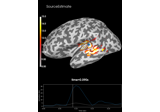mne.inverse_sparse.mixed_norm¶
- mne.inverse_sparse.mixed_norm(evoked, forward, noise_cov, alpha='sure', loose='auto', depth=0.8, maxit=3000, tol=0.0001, active_set_size=10, debias=True, time_pca=True, weights=None, weights_min=0.0, solver='auto', n_mxne_iter=1, return_residual=False, return_as_dipoles=False, dgap_freq=10, rank=None, pick_ori=None, sure_alpha_grid='auto', random_state=None, verbose=None)[source]¶
Mixed-norm estimate (MxNE) and iterative reweighted MxNE (irMxNE).
Compute L1/L2 mixed-norm solution 1 or L0.5/L2 2 mixed-norm solution on evoked data.
- Parameters
- evokedinstance of
Evokedorlistof instances ofEvoked Evoked data to invert.
- forward
dict Forward operator.
- noise_covinstance of
Covariance Noise covariance to compute whitener.
- alpha
float|str Regularization parameter. If float it should be in the range [0, 100): 0 means no regularization, 100 would give 0 active dipole. If
'sure'(default), the SURE method from 3 will be used.Changed in version 0.24: The default was changed to
'sure'.- loose
float| ‘auto’ |dict Value that weights the source variances of the dipole components that are parallel (tangential) to the cortical surface. Can be:
- float between 0 and 1 (inclusive)
If 0, then the solution is computed with fixed orientation. If 1, it corresponds to free orientations.
'auto'(default)Uses 0.2 for surface source spaces (unless
fixedis True) and 1.0 for other source spaces (volume or mixed).
- dict
Mapping from the key for a given source space type (surface, volume, discrete) to the loose value. Useful mostly for mixed source spaces.
- depth
None|float|dict How to weight (or normalize) the forward using a depth prior. If float (default 0.8), it acts as the depth weighting exponent (
exp) to use None is equivalent to 0, meaning no depth weighting is performed. It can also be adictcontaining keyword arguments to pass tomne.forward.compute_depth_prior()(see docstring for details and defaults). This is effectively ignored whenmethod='eLORETA'.Changed in version 0.20: Depth bias ignored for
method='eLORETA'.- maxit
int Maximum number of iterations.
- tol
float Tolerance parameter.
- active_set_size
int|None Size of active set increment. If None, no active set strategy is used.
- debiasbool
Remove coefficient amplitude bias due to L1 penalty.
- time_pcabool or
int If True the rank of the concatenated epochs is reduced to its true dimension. If is ‘int’ the rank is limited to this value.
- weights
None|array|SourceEstimate Weight for penalty in mixed_norm. Can be None, a 1d array with shape (n_sources,), or a SourceEstimate (e.g. obtained with wMNE, dSPM, or fMRI).
- weights_min
float Do not consider in the estimation sources for which weights is less than weights_min.
- solver‘prox’ | ‘cd’ | ‘bcd’ | ‘auto’
The algorithm to use for the optimization. ‘prox’ stands for proximal iterations using the FISTA algorithm, ‘cd’ uses coordinate descent, and ‘bcd’ applies block coordinate descent. ‘cd’ is only available for fixed orientation.
- n_mxne_iter
int The number of MxNE iterations. If > 1, iterative reweighting is applied.
- return_residualbool
If True, the residual is returned as an Evoked instance.
- return_as_dipolesbool
If True, the sources are returned as a list of Dipole instances.
- dgap_freq
intornumpy.inf The duality gap is evaluated every dgap_freq iterations. Ignored if solver is ‘cd’.
- rank
None| ‘info’ | ‘full’ |dict This controls the rank computation that can be read from the measurement info or estimated from the data. When a noise covariance is used for whitening, this should reflect the rank of that covariance, otherwise amplification of noise components can occur in whitening (e.g., often during source localization).
NoneThe rank will be estimated from the data after proper scaling of different channel types.
'info'The rank is inferred from
info. If data have been processed with Maxwell filtering, the Maxwell filtering header is used. Otherwise, the channel counts themselves are used. In both cases, the number of projectors is subtracted from the (effective) number of channels in the data. For example, if Maxwell filtering reduces the rank to 68, with two projectors the returned value will be 66.'full'The rank is assumed to be full, i.e. equal to the number of good channels. If a
Covarianceis passed, this can make sense if it has been (possibly improperly) regularized without taking into account the true data rank.dictCalculate the rank only for a subset of channel types, and explicitly specify the rank for the remaining channel types. This can be extremely useful if you already know the rank of (part of) your data, for instance in case you have calculated it earlier.
This parameter must be a dictionary whose keys correspond to channel types in the data (e.g.
'meg','mag','grad','eeg'), and whose values are integers representing the respective ranks. For example,{'mag': 90, 'eeg': 45}will assume a rank of90and45for magnetometer data and EEG data, respectively.The ranks for all channel types present in the data, but not specified in the dictionary will be estimated empirically. That is, if you passed a dataset containing magnetometer, gradiometer, and EEG data together with the dictionary from the previous example, only the gradiometer rank would be determined, while the specified magnetometer and EEG ranks would be taken for granted.
The default is
None.New in version 0.18.
- pick_ori
None| “normal” | “vector” Options:
NonePooling is performed by taking the norm of loose/free orientations. In case of a fixed source space no norm is computed leading to signed source activity.
"normal"Only the normal to the cortical surface is kept. This is only implemented when working with loose orientations.
"vector"No pooling of the orientations is done, and the vector result will be returned in the form of a
mne.VectorSourceEstimateobject.
- sure_alpha_grid
array|str If
'auto'(default), the SURE is evaluated along 15 uniformly distributed alphas between alpha_max and 0.1 * alpha_max. If array, the grid is directly specified. Ignored if alpha is not “sure”.New in version 0.24.
- random_state
int|None The random state used in a random number generator for delta and epsilon used for the SURE computation. Defaults to None.
New in version 0.24.
- verbosebool |
str|int|None Control verbosity of the logging output. If
None, use the default verbosity level. See the logging documentation andmne.verbose()for details. Should only be passed as a keyword argument.
- evokedinstance of
- Returns
- stc
SourceEstimate|listofSourceEstimate Source time courses for each evoked data passed as input.
- residualinstance of
Evoked The residual a.k.a. data not explained by the sources. Only returned if return_residual is True.
- stc
See also
References
- 1
Alexandre Gramfort, Matthieu Kowalski, and Matti S. Hämäläinen. Mixed-norm estimates for the M/EEG inverse problem using accelerated gradient methods. Physics in Medicine and Biology, 57(7):1937–1961, 2012. doi:10.1088/0031-9155/57/7/1937.
- 2
Daniel Strohmeier, Yousra Bekhti, Jens Haueisen, and Alexandre Gramfort. The iterative reweighted mixed-norm estimate for spatio-temporal MEG/EEG source reconstruction. IEEE Transactions on Medical Imaging, 35(10):2218–2228, 2016. doi:10.1109/TMI.2016.2553445.
- 3
Charles-Alban Deledalle, Samuel Vaiter, Jalal Fadili, and Gabriel Peyré. Stein unbiased gradient estimator of the risk (sugar) for multiple parameter selection. SIAM Journal on Imaging Sciences, 7(4):2448–2487, 2014. URL: https://doi.org/10.1137/140968045, doi:10.1137/140968045.

